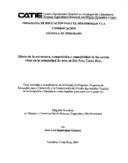Efecto de la estructura, composición y conectividad de las cercas vivas en la comunidad de aves en Río Frío, Costa Rica

View/
Date
2005Author
Santivañez Galarza, José L.
Autor Corporativo
CATIE - Centro Agronómico Tropical de Investigación y Enseñanza
Type
Tesis de maestría
Metadata
Show full item recordAlternative title
Effects of live fence composition, structure and connectivity on bird communities in Río Frío, Costa Rica
Description
Tesis (Mag.Sc.) -- CATIE, 2005
Abstract
El objetivo de este estudio fue caracterizar la comunidad aviar que frecuenta y utiliza las cercas vivas, así como el determinar el efecto de la composición, estructura y grado de conectividad de las cercas sobre la comunidad de aves presente. Entre Febrero y Agosto del 2004 se caracterizó la comunidad arbórea y aviar en 62 cercas vivas en la localidad de Río Frío, Costa Rica. Las comunidades de aves fueron caracterizados en dos especies de cercas vivas (Gliricidia sepium y Erythrina costaricensis) y en 5 diferentes grados de conectividad (conectadas a bosques densos intervenidos, conectadas a bosques riparios, con dobles conexiones, interconectadas o red de cercas vivas y libres o sin conexión). En cada cerca viva, se caracterizó la composición florística y estructural por medio de inventarios florísticos, así como la abundancia, riqueza y diversidad aviar por puntos fijos de conteo. Se concluye que las características de composición y estructura de las cercas vivas son las variables más importantes para mantener y conservar aves en un paisaje fragmentado, con una mayor diversidad de aves en cercas vivas que presentaron árboles altos, copas más grandes, densidades altas, y una mayor riqueza arbórea. The objective of this study was to characterize the bird community visiting live fences, and to determine the effects of live fence composition, structure and connectivity on the bird community present. From February to August, 2004, the tree and bird communities present in 62 live fences were characterized in Rio Frio, Costa Rica. Bird communities were evaluated in two species of live fence (Gliricidia sepium and Erythrina costaricensis) and five degrees of connectivity (connected to forests, connected to riparian forests, with double connections, interconnected to other live fences or without connections). In each live fence, the structural and floristic composition were evaluated through vegetation inventories, while bird abundance, species richness and diversity were evaluated using fixed point counts. It is concluded that the composition and structure of live fences are the most important variables for maintaining and conserving birds within fragmented landscapes, with greater bird diversity in live fences with high trees, large crowns, and greater tree density and species richness.
Keywords
Delegation
Sede Central
Asesor
Harvey, C.
Publisher
CATIE, Turrialba (Costa Rica)
URI (Permanet link to cite or share this item)
https://repositorio.catie.ac.cr/handle/11554/4869Collections
- Tesis [1992]

